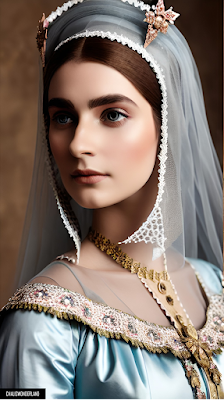- Get link
- X
- Other Apps
CHALIS WONDERLAND
- Get link
- X
- Other Apps
The history of fashion design is a fascinating journey that spans centuries, reflecting the evolution of culture, society, and artistic expression. From its humble beginnings in ancient civilizations to the multi-billion-dollar industry it is today, fashion design has undergone significant transformations in terms of styles, techniques, colours, cuts, and patterns.
Ancient Civilizations:
Fashion design can be traced back to ancient civilizations such as Egypt, Mesopotamia, Greece, and Rome. In these early societies, clothing was primarily functional, serving as protection from the elements and reflecting the social status of individuals. Brightly coloured fabrics, elaborate jewellery, and intricate patterns were characteristic of these ancient fashion styles. Fabrics were often made from natural materials like linen, wool, and silk, and colours were derived from plant-based dyes. The cut and silhouette of clothing varied depending on the period and region.
Changes in Colors, Cuts, and Patterns:
Colours in fashion have varied greatly throughout history. Ancient civilizations primarily used natural dyes, resulting in earthy tones and muted colours. The Renaissance period brought brighter and bolder hues, while the Victorian era favoured dark and sombre shades. The 20th century witnessed the advent of synthetic dyes, leading to a wider range of vibrant colours.
Cuts and silhouettes have evolved dramatically over time. From the flowing togas of ancient Rome to the structured corsets and bustles of the Victorian era.
Medieval and Renaissance Periods:
During the medieval period, fashion was heavily influenced by the class structure. Fashion design became more elaborate and stylized, reflecting the rise of feudalism and the influence of the Church. Clothing was a symbol of status and power, with royalty and nobility adorning themselves in luxurious fabrics, rich colours, and ornate embroidery, while the lower classes wore simpler garments. The Renaissance period marked a significant shift in fashion with an emphasis on the individual and the rebirth of classical Greek and Roman styles. The concept of fashion began to extend beyond functionality and became a form of personal expression. Colours became more vibrant, and patterns like florals and geometric motifs gained popularity.
The Renaissance period marked a shift towards a more humanistic approach to fashion design. Inspired by the revival of classical art and culture, clothing became more tailored and emphasized the natural shape of the body. Silhouettes evolved to include voluminous sleeves, corsets, and wide skirts for women, while men adopted doublets and breeches. Rich, vibrant colours such as deep reds, blues, and gold were favoured, often enhanced by intricate patterns and embellishments.
18th and 19th Centuries:
The 18th century witnessed the rise of Rococo fashion, characterized by extravagant, ethereal styles that were inspired by nature. Women's clothing featured intricate lace, delicate pastel colours, and wide skirts supported by hoops or panniers. Men's fashion became more refined, with tailored suits, powdered wigs, and knee-length breeches.
Fashion became a way for the aristocracy to display their wealth and status. Influential figures such as Marie Antoinette in France and Beau Brummell in England set the trends of the time. Pastel colours, corsets, and intricate embellishments characterized the fashion of this period.
The 19th century saw the advent of the Industrial Revolution, which brought significant changes to fashion design. The rise of mass production allowed for the availability of ready-to-wear clothing, making fashion accessible to a wider audience. Silhouettes changed dramatically throughout the century, from the Regency era's empire waistlines to the exaggerated hourglass shapes of the Victorian era. The invention of synthetic dyes introduced a broader range of colours, including deep purples, emerald greens, and rich browns.
20th Century and Beyond:
The 20th century brought radical shifts in fashion design. It marked a period of rapid change and innovation in fashion. The early decades saw the rise of fashion designers as influential figures. The Art Nouveau and Art Deco movements influenced the early part of the century, showcasing geometric patterns, bold colours, and sleek, streamlined silhouettes. The 1920s introduced the "Roaring Twenties" and the flapper style, characterized by short dresses, dropped waistlines, and bold colours and patterns. The 1930s and 1940s were influenced by the Great Depression and World War II, resulting in more practical and modest clothing styles.
The mid-20th century witnessed significant changes, as designers like Christian Dior introduced the concept of haute couture and the "New Look," characterized by cinched waists, full skirts, and a return to femininity. The post-war period witnessed a fashion revolution with the introduction of Christian Dior's "New Look" in 1947. This style featured nipped-in waists, full skirts, and a return to femininity and luxury. The subsequent decades brought about various subcultures and fashion movements, such as the mod style of the 1960s, the bohemian and hippie fashion of the 1970s, and the eclectic and rebellious fashion of the 1980s.
In recent years, fashion design has become more inclusive and diverse, with a greater emphasis on individuality and personal style. Designers experiment with a wide range of colours, cuts, and patterns, catering to a global market with diverse tastes and cultural influences. Technology has also revolutionized the industry, allowing for the creation of innovative fabrics, 3D printing, and digital pattern-making. With the internet and social media, trends can spread rapidly across the globe, leading to a more diverse and eclectic fashion landscape. Sustainability and ethical fashion have also gained prominence, with designers and consumers becoming more conscious of the environmental and social impact of the industry.
Today, fashion designers draw inspiration from a variety of sources, including art, music, subcultures, and global trends. The industry continues to evolve, reflecting the ever-changing desires.
- Get link
- X
- Other Apps




Comments